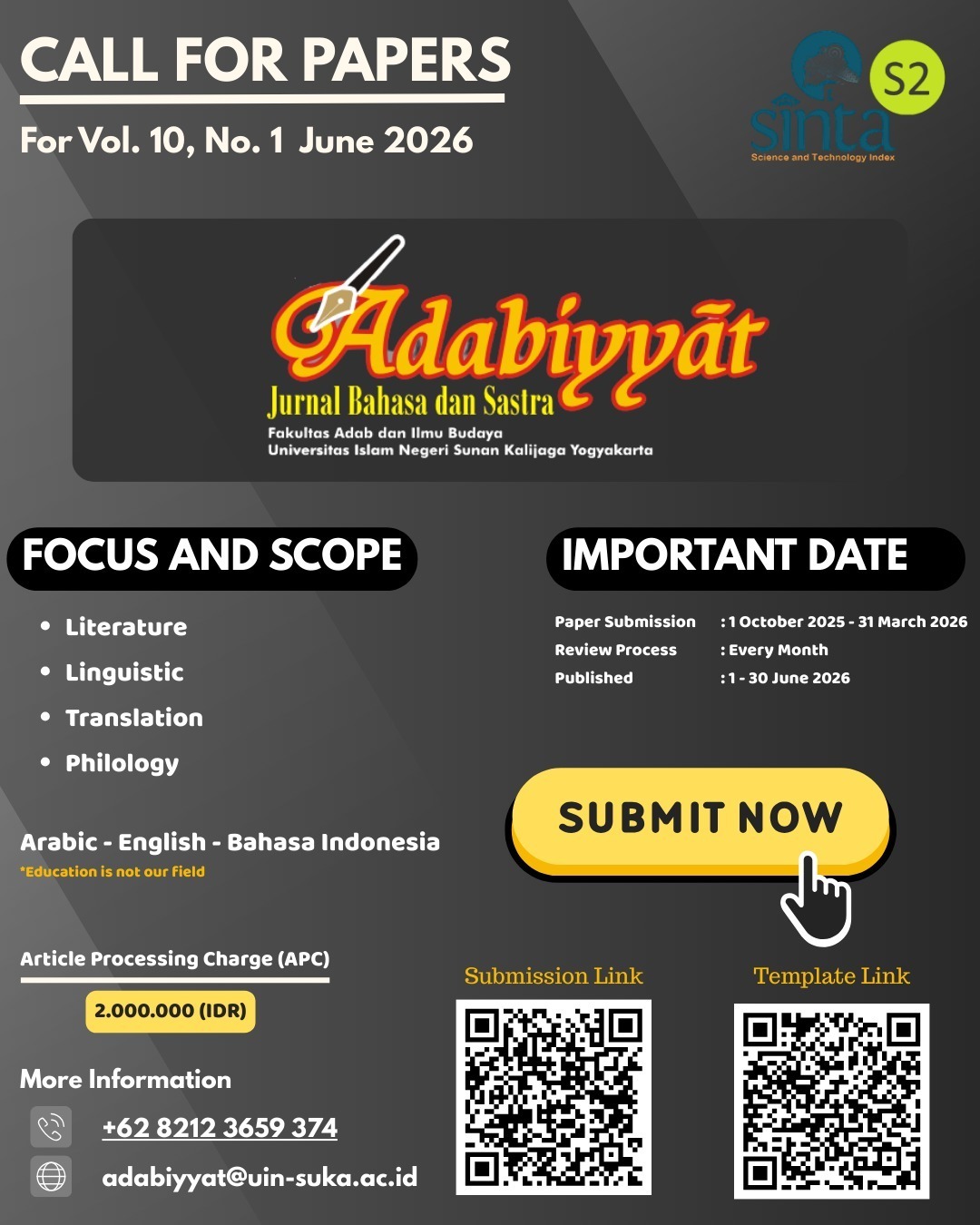ANALISIS KOMPARASI KAJIAN TERJEMAHAN INGGRIS-ARAB DAN INGGRIS-INDONESIA PADA LIRIK LAGU BTS
DOI:
https://doi.org/10.14421/ajbs.2023.07021Keywords:
BTS song lyrics, translation technique, translation method, translation ideologyAbstract
Subtitles on YouTube are automatically machine-translated and sometimes the translations are difficult to understand. One of the applications is done on BTS song lyrics. The purpose of this study is to compare the application of techniques as well as the tendency of English-Arabic and English-Indonesian translation methods and ideologies in BTS song lyrics. This research is a descriptive qualitative research. The translation theories underlying this research are translation techniques, methods, and ideologies. The data in this study are clauses or sentences in the lyrics of BTS songs and their translations in Arabic and Indonesian. The data collection technique was done by listening and noting. The data were analyzed by combining two analysis models, namely interactive (Miles and Huberman) and ethnographic (Spradley) models. The results of this study show that the dominant application of translation techniques in English-Arabic translation is the established equivalent technique, while in English-Indonesian translation it is the literal technique. Meanwhile, the English-Arabic translation method is target language-oriented, while the English-Indonesian translation method is source language-oriented. This affects the domestication ideology orientation in English-Arabic translation and the foreignization ideology orientation in English-Indonesian translation.
Downloads
References
Abd-Rahim, Atiqah. 2019. “Online Fandom: Social Identity and Social Hierarchy of Hallyu Fans.” Journal for Undergraduate Ethnography 9 (1): 65–81. https://doi.org/10.15273/jue.v9i1.8885.
Agy, Sarah, dan Anggraeni Anggraeni. 2019. “Analisis Teknik dan Metode Penerjemahan Lirik Lagu Bahasa Indonesia ke dalam Bahasa Mandarin pada Channel Youtube.” Longda Xiaokan: Journal of Mandarin Learning and Teaching 2 (2).
Aprilia, Yessi Ika, dan Domloboy Nasution. 2023. “Strategi Korea Selatan dalam Penyebaran Budaya K-Pop Melalui Grup Musik BTS.” Jurnal Sosial Politik Integratif 3 (1): 413–18.
Choi, Yong-Seok, dir. 2020. Dynamite Official MV. Hybe Labels. https://www.youtube.com/watch?v=gdZLi9oWNZg.
———, dir. 2021a. Butter Official MV. Hybe Labels. https://www.youtube.com/watch?v=WMweEpGlu_U.
———, dir. 2021b. Permission to Dance Official MV. Hybe Labels. https://www.youtube.com/watch?v=CuklIb9d3fI.
Echols, John M, dan Hasan Shadily. 1976. Kamus Inggris-Indonesia. Ed. 1. Jakarta: Gramedia Pustaka Utama.
Farah, A., R.N. Karim, dan M. Said. 2004. The Dictionary English-Arabic: General & Scientific Dictionary of Language and Terms. Beirut: Dar al-Kotob al-Ilmiyah.
Franzon, Johan. 2008. “Choices in Song Translation: Singability in Print, Subtitles and Sung Performance.” The Translator 14 (2): 373–99. https://doi.org/10.1080/13556509.2008.10799263.
Ghalayayn, Musthofa. 1994. Jāmi’u Durūs al-’Arabiyah. Vol. 2. 3 vol. al-Maktabah al-’Aṣriyyah. http://archive.org/details/WAQ33751.
Kardijan, Dian. 2019. “Analisis Penerjemahan Lirik Lagu ‘It’s My Life’ Karya Bon Jovi Versi Tautan Http://Gudang-Terjemahan-Lagu.Blogspot.Co.Id.” Jurnal Siliwangi: Seri Pendidikan 5 (1). https://doi.org/10.37058/jspendidikan.v5i1.742.
Mersita, Meri. 2022. “Analisis Semiotika Charles Sanders Peirce Pada Music Video Permission To Dance Oleh BTS.” Skripsi, Universitas Islam Riau. https://repository.uir.ac.id/15054/.
Miles, Matthew B., dan A. Michael Huberman. 1994. Qualitative Data Analysis: An Expanded Sourcebook. Ed. 2. Thousand Oaks: Sage Publications.
Molina, Lucía, dan Amparo Hurtado Albir. 2002. “Translation techniques revisited: A dynamic and functionalist approach.” Meta 47 (4): 498–512.
Molina, Lucía, dan Amparo Hurtado Albir. 2002. “Translation Techniques Revisited: A Dynamic and Functionalist Approach.” Meta 47 (4): 498–512. https://doi.org/10.7202/008033ar.
Newmark, Peter. 1988. A Text Book of Translation. Great Britain: Prentince International Ltd.
Nida, Eugene A., dan Charles R. Taber. 1974. The Theory and Practice of Translation. Leiden: E.J. Brill.
Putri, Annisa, Hermandra Hermandra, dan Nana Rahayu. 2019. “Analisis Terjemahan Lirik Lagu Berbahasa Indonesia Ke Dalam Bahasa Jepang Oleh Hiroaki Kato.” Jurnal Online Mahasiswa (JOM) Bidang Keguruan Dan Ilmu Pendidikan 6 (2): 154–63.
Putri, Ratu Laura Mulia Baskara, Ratu Nadya Wahyuningratna, dan Vinta Sevilla. 2022. “Representasi Kecemasan dan Hopelessness dalam Lirik Lagu BTS "Black Swan” (Kajian Semiotika Roland Barthes).” Ekspresi dan Persepsi: Jurnal Ilmu Komunikasi 5 (1): 58–70. https://doi.org/10.33822/jep.v5i1.3108.
Rasyid, Kamal. 2008. al-Zamān al-Nahwi fī al-Lugah al-’Arabiyah. Oman: Alim al-Tsaqofah Publishing.
Siswantoro. 2010. Jenis-jenis Sastra dalam Macam Gaya Bahasa. Semarang: Dunia Percetakan Maju.
Spradley, James P. 1979. The Ethnographic Interview. Orlando: Harcourt Brace Jovanovich College Publisher.
Sugono, Dendy. 2008. Kamus Bahasa Indonesia. Jakarta: Pusat Bahasa Departemen Pendidikan Nasional.
Ummah, Mutiara Rahmatul. 2021. “Perbandingan Metode Penerjemahan Lirik Lagu Aisyah Istri Rasulullah dalam Empat Versi Terjemahan.” Skripsi, Surakarta: Universitas Sebelas Maret. https://digilib.uns.ac.id/dokumen/99506/Perbandingan-Metode-Penerjemahan-Lirik-Lagu-Aisyah-Istri-Rasulullah-dalam-Empat-Versi-Terjemahan.
Venuti, Lawrence. 1995. The Translator’s Invisibility: A History of Translation. Third edition. New York: Routledge.
Wehr, Hans. 1976. A Dictionary of Modern Written Arabic. New York: Spoken Language Services.
Zuliyanti, Evi, Mohamad Yusuf Ahmad Hasyim, dan Zaim Elmubarok. 2019. “I’rab al-Fi’il al-Mudhāri’ Dalam Al-Qur’an Juz 26 Sampai 30 (Analisis Sintaksis).” Lisanul Arab: Journal of Arabic Learning and Teaching 8 (2): 146–53. https://doi.org/10.15294/la.v8i2.36170.
Downloads
Additional Files
Published
Issue
Section
License
Copyright (c) 2023 Khoirunnisa Rahmawati, Abdul Malik

This work is licensed under a Creative Commons Attribution-ShareAlike 4.0 International License.
- Adabiyyāt: Jurnal Bahasa dan Sastra publishes all articles entirely in full text.
- It is permissible for readers to download and to use it for scientific purposes and scientific dissemination.
- The author can re-publish the article that has been published by the Adabiyyāt: Jurnal Bahasa dan Sastra after obtaining written permission from the editor. This letter can be obtained by submitting a request letter for permission to republish the article to Adabiyyāt: Jurnal Bahasa dan Sastra via email adabiyyat@uin-suka.ac.id. In the second publication, the author is required to include information that the article was firstly published by the Adabiyyāt: Jurnal Bahasa dan Sastra.









